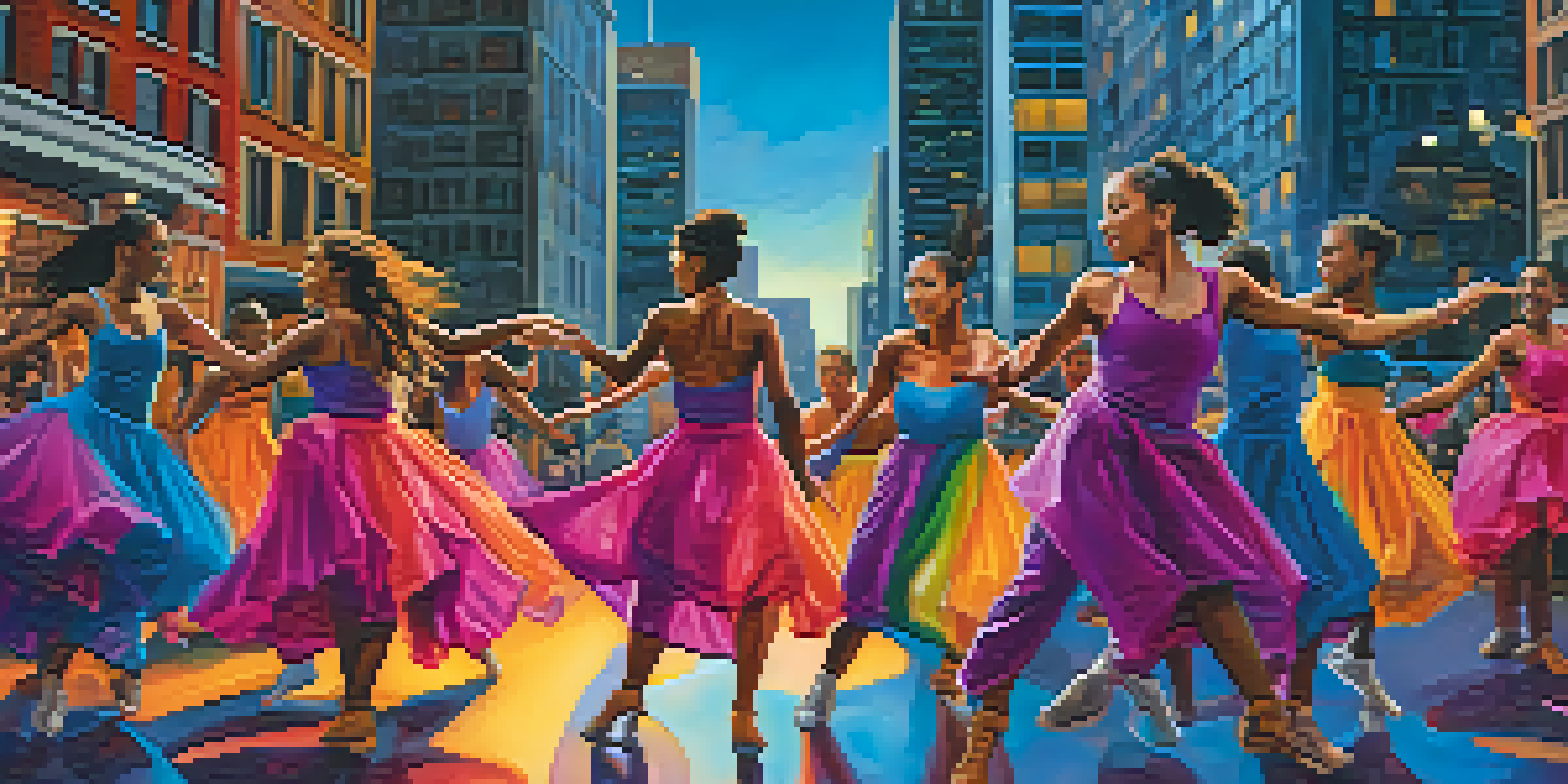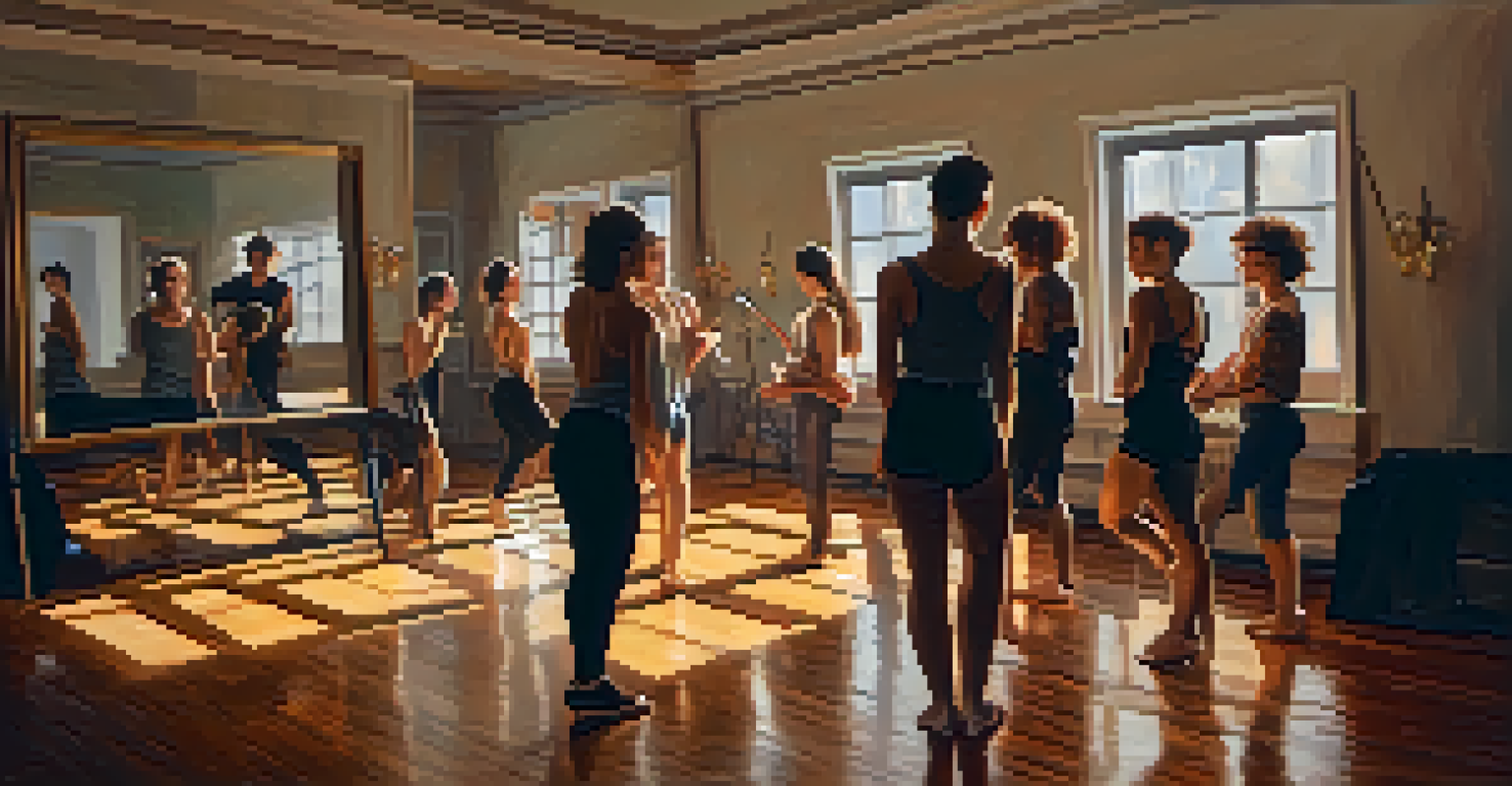Queer Dance Movements: Redefining Gender in Performance Art

Introduction to Queer Dance Movements
Queer dance movements have emerged as a vibrant expression of identity, challenging traditional notions of gender in performance art. These innovative styles often blend various dance forms, creating a space where artists can explore and redefine what gender means to them. By embracing fluidity and breaking away from conventional norms, queer dance invites audiences to reconsider their perceptions of gender identity.
Dance is the hidden language of the soul.
Dance has always been a medium of expression, but queer dance goes a step further by intertwining personal narratives with societal critiques. The movements not only showcase individuality but also serve as a commentary on the broader LGBTQ+ experience. This rich tapestry of expression highlights the beauty of diversity and the importance of representation in the arts.
As we delve into the world of queer dance, we will uncover how these movements challenge established gender roles, foster community, and create a dialogue about identity. The journey through this artistic landscape reveals not just dance, but a movement that is reshaping cultural norms.
Historical Context of Queer Dance
To understand queer dance movements today, it's essential to look back at their historical roots. From the Harlem Renaissance to the Stonewall riots, dance has played a pivotal role in expressing the struggles and triumphs of the LGBTQ+ community. These historical moments not only fueled the evolution of queer dance but also laid the groundwork for today's performances.

Pioneering artists like Alvin Ailey and Martha Graham explored themes of identity and sexuality long before the term 'queer' gained traction. Their works opened doors for future generations of dancers to express themselves freely and authentically. As the LGBTQ+ rights movement gained momentum in the late 20th century, so too did the visibility of queer dance as a powerful form of artistic rebellion.
Queer Dance Challenges Gender Norms
Queer dance movements redefine traditional gender roles, allowing artists to express fluid identities and foster community dialogue.
This historical context enriches our understanding of the current landscape of queer dance, providing insights into the challenges faced by artists and the resilience they embody. By acknowledging this legacy, we can appreciate how far the movement has come and the ongoing battles for acceptance and recognition.
Key Characteristics of Queer Dance
One of the defining characteristics of queer dance is its celebration of gender fluidity. Unlike traditional dance forms that often adhere to strict gender roles, queer dance encourages performers to explore and express their identities in diverse ways. This fluidity not only enhances the performance but also resonates with audiences, inviting them to reflect on their own understanding of gender.
We are all born with a unique set of gifts, and the world needs to see those gifts, not just the ones that are acceptable.
Additionally, queer dance often incorporates elements of storytelling, where each movement tells a personal story or conveys a broader social message. This narrative aspect allows dancers to connect with viewers on an emotional level, fostering empathy and understanding. Through this lens, dance becomes a powerful tool for advocacy and change.
Moreover, the collaborative nature of queer dance movements promotes inclusivity and community-building. Dancers from various backgrounds come together to share their experiences, creating a supportive environment that nurtures creativity and self-expression. This sense of belonging is crucial for many performers, as it challenges the isolation often felt within society.
Notable Queer Dance Artists
Several artists have made significant contributions to the queer dance movement, each bringing their unique voice and vision. One such artist is Jeremy Wade, known for his work that explores the intersections of race, gender, and sexuality through powerful choreography. His performances challenge audiences to confront uncomfortable truths while celebrating diversity.
Another influential figure is Eiko Otake, who uses dance to express themes of vulnerability and resilience. Her performances often draw upon personal experiences, allowing her to connect deeply with audiences. Eiko's work exemplifies how queer dance can transcend boundaries and foster a sense of shared humanity.
Historical Roots Shape Current Art
The evolution of queer dance is deeply rooted in significant historical events and figures, highlighting the ongoing struggles and triumphs of the LGBTQ+ community.
These artists, among many others, serve as beacons of inspiration within the queer dance community. Their innovative approaches not only redefine performance art but also encourage emerging dancers to embrace their identities and challenge societal norms.
The Role of Technology in Queer Dance
In today's digital age, technology plays a crucial role in the evolution of queer dance movements. From social media platforms to virtual performances, artists are finding new ways to showcase their work and reach wider audiences. This accessibility allows for a diverse range of voices and styles to emerge, enriching the queer dance landscape.
Streaming platforms have opened up opportunities for queer dance artists to share their performances globally, breaking geographical barriers. This shift not only amplifies visibility but also fosters connections among dancers and audiences from different cultures and backgrounds. The result is a vibrant exchange of ideas and influences that push the boundaries of dance.
Additionally, technology has enabled innovative collaborations, where artists can experiment with multimedia elements in their performances. This fusion of dance and technology creates immersive experiences that captivate audiences and challenge traditional notions of what dance can be. As queer dance continues to evolve, technology will undoubtedly play a pivotal role in shaping its future.
Queer Dance and Community Building
At its core, queer dance is about building community and fostering connections among individuals. Many dance companies and collectives prioritize inclusivity, creating safe spaces for LGBTQ+ dancers to express themselves freely. These environments encourage collaboration, creativity, and a sense of belonging that is often lacking in mainstream dance settings.
Community-building initiatives, such as workshops and performances, allow dancers to share their stories and experiences with one another. This exchange not only strengthens bonds within the community but also empowers individuals to embrace their identities. The support found within these circles can be transformative, providing the confidence needed to take artistic risks.
Technology Expands Dance Accessibility
In the digital age, technology enhances the visibility of queer dance, enabling artists to reach wider audiences and explore innovative performance styles.
Moreover, queer dance often serves as a form of activism, addressing pressing social issues and advocating for change. By raising awareness through their art, dancers can inspire audiences to engage with important conversations around gender, sexuality, and identity. In this way, queer dance becomes a vehicle for community empowerment and social justice.
The Future of Queer Dance Movements
As we look to the future, queer dance movements are poised to continue evolving and reshaping the landscape of performance art. With increasing visibility and acceptance, more artists are stepping into the spotlight, bringing fresh perspectives and innovative ideas. This momentum promises to challenge the status quo and inspire new generations of dancers.
The integration of diverse cultural influences will further enrich the queer dance narrative, as artists draw upon their unique backgrounds and experiences. This blending of styles and traditions fosters a dynamic artistic environment that reflects the complexity of identity in today's world. As queer dance becomes more mainstream, it will likely spark important conversations about representation and inclusivity.

Ultimately, the future of queer dance lies in its ability to adapt and respond to societal changes. As artists continue to push boundaries and explore new frontiers, they will not only redefine performance art but also contribute to a broader understanding of gender and identity. The journey ahead is one of discovery, innovation, and empowerment for all involved.